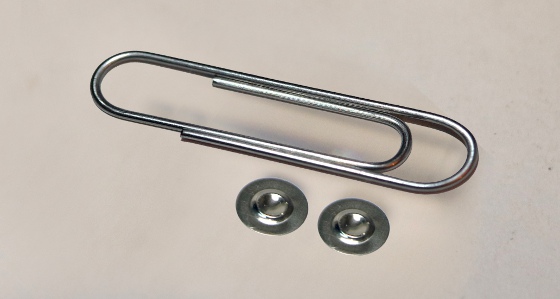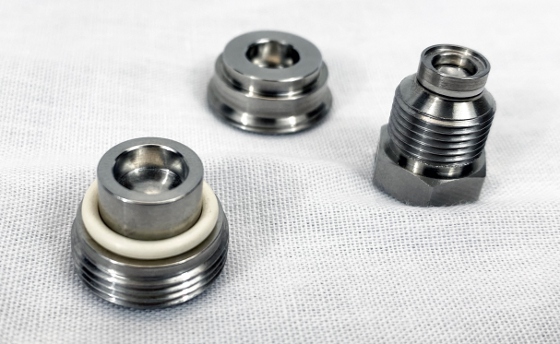 |
| February 14, 2023 | Volume 19 Issue 06 |
Designfax weekly eMagazine
Archives
Partners
Manufacturing Center
Product Spotlight
Modern Applications News
Metalworking Ideas For
Today's Job Shops
Tooling and Production
Strategies for large
metalworking plants
New developments in integrated rupture disk assemblies: Cryogenic equipment and more
By Jeff Elliott
Today, cryogenics is used to provide convenient storage of large quantities of industrial gases such as nitrogen, oxygen, carbon dioxide, argon, helium, and hydrogen that are vaporized from liquid to gas at time of use in support of many industrial processes ranging from steelmaking to medical systems and welding. Additionally, cryogenic equipment provides stable, cold temperatures required to preserve biological samples, support superconducting magnets such as those used in medical imaging systems and particle physics experiments, as well as to support novel surgical procedures and materials research.
Custom engineered, miniature rupture disk assemblies like those from BS&B Systems protect cryogenic systems and tanks from overpressurization. [Photo credit: Audio und werbung/Shutterstock.com -- All images courtesy: BS&B Safety Systems]
Within these systems, liquefied gases such as helium, hydrogen, nitrogen, carbon dioxide, and oxygen are kept at very low temperatures, since the boiling points for these gases are very low, ranging from -78.5°C (-109.3°F) for liquid carbon dioxide to -269°C (-452.2°F) for liquid helium. Due to its physical properties, as temperature rises, a very small amount of liquid can expand rapidly into a very large volume of gas.
For example, the expansion ratio of nitrogen is 694 -- with 1 liter of liquid nitrogen becoming 694 liters of gaseous nitrogen at standard temperature and pressure (ambient conditions). If the insulation or other cooling methods used to maintain cryogenic temperature conditions for a liquid are lost, a rapid buildup of pressure will occur in any closed tank or vessel in which the liquid is contained.
For these reasons, cryogenic systems are equipped with pressure-relief devices such as rupture disks to protect against rapid pressure rise caused by a sudden increase of heat into cryogenic systems, cryogenic shippers, cryostats, cannisters, and associated piping. For applications that utilize superfluid helium to cool superconducting magnets used in magnetic resonance imaging equipment, particle accelerators, and for semiconductor processing, rupture disks protect against the sudden catastrophic loss of insulating vacuum or insulating nitrogen in the storage vessel or experimental enclosure.
The rupture disk, which is a one-time-use membrane made of various metals including exotic alloys, is designed to activate within milliseconds when a pre-determined differential pressure is achieved. However, given the critical reliability of the equipment in operation and during storage/transport, this demands high-integrity pressure-relief technology.
As a result, OEMs are increasingly turning to integrated rupture disk assemblies with all components combined by the manufacturer, as opposed to loose rupture disk and holder devices that leave much to chance. These assemblies are being tailored to the application, miniaturized, and utilize a wide range of standard and exotic materials, as required. This approach ensures the rupture disk device performs as expected, enhancing equipment safety, reliability, and longevity while simplifying installation and replacement.
Separate components versus integrated assemblies
Traditionally, rupture disks have been standalone components that are combined with the manufacturer's separate holder device at the point of use. The installation actions of the user contribute significantly to the function of the rupture disk device. When installed improperly, the rupture disk may not burst at the expected set pressure. There is a delicate balance between the rupture disk membrane, its supporting holder, and the flanged, threaded, or other fastening arrangement used to locate the safety device on the protected equipment.

With the availability of integrated, miniaturized rupture disk solutions tailored to the application in a variety of standard and exotic materials, OEMs like BS&B can enhance equipment safety, compliance, and reliability even in extreme work conditions. [All images courtesy: BS&B Safety Systems]
For this reason, an integrated rupture disk assembly is often a better choice than separable parts. Available ready-to-use and with no assembly required, integrated units are certified as a device to perform at the desired set pressure. The one-piece design allows for easier installation and quick removal if the rupture disk is activated.
The assembly includes the rupture disk and housing and is custom engineered to work with the user's desired interface to the pressurized equipment. The devices are typically threaded or flanged, or even configured for industry-specific connections such as CF/KF/Biotech industry clamp connections/VCR couplings. The rupture disk and holder are combined by the manufacturer by welding, bolting, tube stub, or crimping based on the application conditions and leak tightness requirements.
There are additional advantages to this approach. Integrated assemblies prevent personnel from utilizing unsafe or self-rigged solutions to replace an activated rupture disk to save a few dollars or rush equipment back online. The physical characteristics of increasingly miniaturized rupture disks as small as 1/8 in. can also make it challenging for personnel to pick up the disk and place it into a separate holder.
"Cryogenic equipment OEMs are driven to deliver the safest operation as well as longest life and lowest cost of ownership to their customers, says Geof Brazier, managing director of BS&B Safety Systems Custom Engineered Products Division. "The use of an integral assembly maximizes the longevity, proper function, and trouble-free service of the pressure-relief technology."
Integrated assemblies -- Rupture disk design
According to Brazier, the most important considerations in rupture disk device design are having the right operating pressure and temperature information along with the expected service life, which is often expressed as a number of cycles the device is expected to endure during its lifetime. Since pressure and cycling varies depending on the application, each requires a specific engineering solution.
"Coming up with a good, high-reliability, cost-effective, and application-specific solution for cryogenic equipment involves selecting the right disk technology, the correct interface (weld, screw threads, compression fittings, single machined part), and the right options as dictated by the codes and standards," says Brazier.
Because user material selection can also determine the longevity of rupture disks, the devices can be manufactured from metals and alloys such as stainless steel, nickel, Monel, Inconel, and Hastelloy.
According to Brazier, for a wide range of industries it can be important for rupture disks to have a miniaturized reverse-buckling capability in both standard and exotic materials.
"Where economics is the driver, reverse-buckling disks are typically made from materials such as nickel, aluminum, and stainless steel. Where aggressive conditions are required, more exotic materials like Monel, Inconel, Hastelloy, titanium, and even tantalum can be used," he says. In almost all cases, reverse-buckling rupture disks are utilized because they outperform the alternatives with respect to service life.
In a reverse-buckling design, the dome of the rupture disk is inverted toward the pressure source. Burst pressure is accurately controlled by a combination of material properties and the shape of the domed structure. By loading the reverse-buckling disk in compression, it can resist operating pressures up to 95% of minimum burst pressure even under pressure cycling or pulsating conditions. The result is greater longevity, accuracy, and reliability over time.
"The process industry has relied on reverse-buckling disks for decades. Now the technology is available to OEMs in miniature form as small as 1/8-in. burst diameter from BS&B. Until recently, obtaining disks of that size and performance was impossible," says Brazier.

The physical characteristics of increasingly miniaturized rupture disks as small as 1/8 in. can make it challenging for personnel to pick up a disk and place it into a separate holder. [All images courtesy: BS&B Safety Systems]
However, miniaturization of reverse-buckling technology presents its own unique challenges. To resolve these issues, BS&B created novel structures that control the reversal of the rupture disk to always activate in a predictable manner. In this type of design, a line of weakness is also typically placed into the rupture disk structure to define a specific opening flow area when the reverse-type disk activates, and also prevents fragmentation of the disk "petal."
"Reverse buckling and therefore having the material in compression does a few things. Number one, the cyclability is much greater. Second, it allows you to obtain a lower burst pressure from thicker materials, which contributes to enhanced accuracy as well as durability," says Brazier.
Small, nominal-size rupture disks are sensitive to the detailed characteristics of the orifice through which they burst. This requires strict control of normal variations in the disk holder.
"With small-size pressure-relief devices, the influence of every feature of both the rupture disk and its holder is amplified," explains Brazier. "With the correct design of the holder and the correct rupture disk selection, the customer's expectations will be achieved and exceeded."
Due to cost, weight, and other considerations, Brazier says that BS&B has increasingly received more requests for housings that are made out of plastics and composites.
Because customers are often accustomed to certain types of fittings to integrate into a piping scheme, different connections can be used on the housing. Threading is popular, but BS&B is increasingly utilizing several other connection types to attach the rupture disk assembly to the application. Once the integral assembly leaves the factory, the goal is that the set pressure cannot be altered.

OEMs like BS&B utilize threading and several other connection types to attach the rupture disk assembly to the application. [All images courtesy: BS&B Safety Systems]
"If you rely on someone to put a loose disk in a system and then capture it by threading over the top of it, unless they follow the installation instructions and apply the correct torque value, there is still potential for a leak or the disk may not activate at the designed burst pressure," explains Brazier. "When welded into an assembly, the rupture disk is intrinsically leak-tight and the set-burst pressure fixed."
While OEMs have relied on rupture disks in their cryogenic equipment, the availability of integrated, miniaturized rupture disk solutions tailored to the application in a variety of standard and exotic materials can significantly enhance equipment safety, compliance, and reliability -- even in extreme work conditions.
BS&B Safety Systems has launched a new website that features an interactive product selection guide (https://www.bsbsafety.co/Product_Selection/) focused on helping process engineers select the correct rupture disk product from the many options the company offers. The web-based tool allows users to input basic application needs, such as product size and set pressure, to find the solutions that best match their requirements. Additional application inputs refine the search. The guide accelerates rupture disk product selection without need for registration.
For more information, contact BS&B Safety Systems at 7455 East 46th Street, Tulsa, OK 74145-6379, call: (918) 622-5950, e-mail: sales@bsbsystems.com, or visit www.bsbsystems.com.
About the author
Jeff Elliott is a Torrance, California-based technical writer. He has written about industrial technologies for the past 20 years.
Published February 2023
Rate this article
View our terms of use and privacy policy
